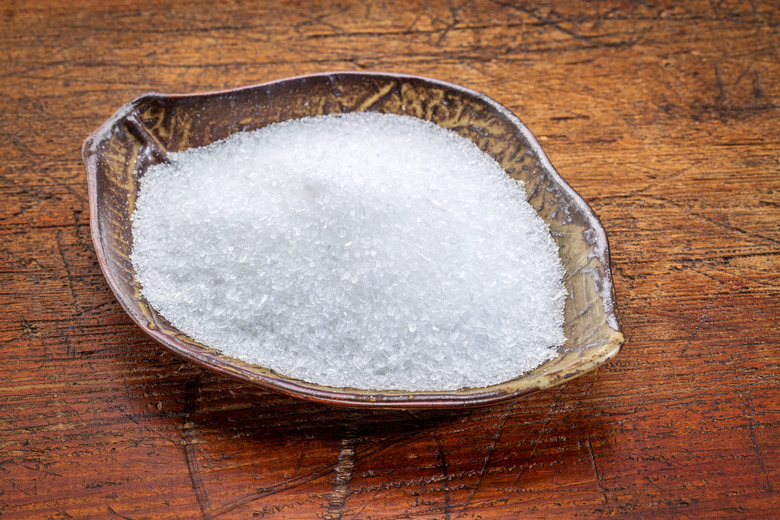What Is A Hydrated Salt?
A hydrated salt is a crystalline salt molecule that is loosely attached to a certain number of water molecules. Salt is created when an acid's anion and a base's cation are combined to produce an acid-base molecule. A salt molecule that is not bound to any water molecules is an anhydrate, and a salt molecule that is bound to water molecules is a hydrated salt. In a hydrated salt, the water molecules are incorporated into the crystalline structure of the salt.
Occurrence of Hydrated Salts
Occurrence of Hydrated Salts
Hydrated salts naturally occur all over the world — including in freshwater. For example, compounds in an area's soil or rock may dissolve into the groundwater, where the free-floating chemicals bind to create salt molecules and hydrate with the groundwater's molecules. One place where that occurred, to create naturally occurring Epsom salt, or magnesium sulfate heptahydrate, is Epsom, England. Since the human body needs many of the chemicals that make up different salts, but those chemicals may be difficult to obtain or absorb through diet alone, places where hydrated salts naturally occur often are traditionally viewed as places for people to heal and take curative baths. For example, such is the case with Epsom. Salts that have a loose enough crystalline structure to incorporate water molecules and become hydrated salts may absorb the water molecules from the water vapor in the air, or become hydrated when in contact with liquid water.
Naming Hydrated Salts
Naming Hydrated Salts
When hydrated, magnesium sulfate becomes magnesium sulfate heptahydarate. The chemical compound is represented as MgSO4(H2O)7. The magnesium sulfate molecule is the MgSO4 portion of the symbol of Epsom salts, and the (H20)7 is meant to show that the magnesium sulfate molecule is bound to seven water (H2O) molecules. The ratio of the salt molecules to water molecules may be more complex — for example, the simplest ratio for hydrated cadmium sulfate is three cadmium sulfate molecules to eight water molecules, so the simplest chemical symbol for the hydrated salt is (CdSO4)3(H2O)8.
Methods of Dehydration of Hydrated Salts
Methods of Dehydration of Hydrated Salts
The severing of the bonds between a salt molecule and the water molecules bound to it in a hydrated salt is called dehydration. The application of relatively gentle heat is usually enough to sever the bonds between the water molecules and the salt molecule of a hydrated salt, though how much heat is necessary is specific to the salt. When the hydrated salt is heated and the salt separates from the water molecules, the proportion of water molecules to salt molecules may be used to determine what the ratio of H2O to salt is in that particular hydrated salt compound.
Reasons for Dehydration of Hydrated Salts
Reasons for Dehydration of Hydrated Salts
Dehydrating a hydrated salt may allow the freed salt to be more easily ingested or absorbed. For example, people who wish to ingest magnesium and sulfate for the health benefits the molecules are meant to provide may dissolve the magnesium sulfate heptahydrate into a hot bath or combine it with hot water to make a poultice. When a person soaks in the bath with the MgSO4 that has been severed from its bonds with water through the heat of the bath, he is able to absorb the free-floating salt through his skin.
References
- Georgia State: Salt
- Epsom and Ewell on the Internet: Epsom Salts
- University of Kiel: Bathing in a Magnesium-Rich Dead Sea Salt Solution Improves Skin Barrier Function, Enhances Skin Hydration, and Reduces Inflammation in Atopic Dry Skin; Proksch E, Nissen HP, Bremgartner M, Urquhart C.; February 2005
Cite This Article
MLA
Rousseau, Sasha. "What Is A Hydrated Salt?" sciencing.com, https://www.sciencing.com/hydrated-salt-8700669/. 25 April 2018.
APA
Rousseau, Sasha. (2018, April 25). What Is A Hydrated Salt?. sciencing.com. Retrieved from https://www.sciencing.com/hydrated-salt-8700669/
Chicago
Rousseau, Sasha. What Is A Hydrated Salt? last modified March 24, 2022. https://www.sciencing.com/hydrated-salt-8700669/
